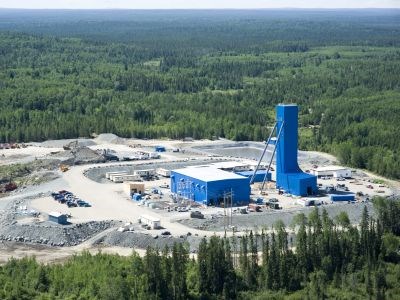The ink was barely dry on the deal to combine Tahoe Resources with Lake Shore Gold Corp. when company officials outlined plans to boost gold production in Timmins.
Tony Makuch, president of Tahoe’s Canadian operations, as well as Tahoe executive chair Kevin McArthur and Tahoe president and COO Ron Clayton, spoke in Timmins about their goal to increase gold production at the Lake Shore Gold Division from about 180,000 ounces of gold to 250,000 in four years.
“That’s going to be achieved through a number of growth projects,” said Mark Utting, Tahoe’s vice-president of investor relations.
Combining the assets and resources of two strong mining companies to create an even stronger entity enables growth to move faster, he predicts.
At the company’s Bell Creek Mine, northeast of Timmins, where Lake Shore produced about 40,000 ounces of gold last year, Tahoe intends to recommission and sink the currently unused shaft from a depth of 290 metres to well below 1,000 metres.
“Maybe as deep as 1,400, but we have to determine that exactly,” Utting said. “That’s going to give us access to a very large resource at depth and … the potential to double production,” he said.
South of Bell Creek, in a joint venture with Goldcorp Inc., the company is the exploration operator on the Whitney Project, an area of former producing gold mines, including the high-grade Hallnor Mine. Over 30,000 metres of diamond drilling has yielded very encouraging results.
“We’re looking at the model of developing an open pit that would eventually transition to underground mining,” Utting said. “That’s another thing that we’re aggressively working on.”
Near the Timmins West Mine, 18 kilometres southwest of the city centre, Lake Shore is conducting development work on the 144 Gap Zone, where it spent $25 million exploring a thick, high-grade gold deposit first discovered in 2013. The company expects to begin test stoping in the second half of this year.
“We’ve already drifted into it from our underground infrastructure at Thunder Creek,” said Utting.
“We’re developing a second drift over there now. We’ll be able to produce from the 144 Gap deposit using our infrastructure. In fact, we’re going to truck the ore right back through Thunder Creek over to the Timmins Deposit, where our shaft is, and bring it up the Timmins West Mine shaft.”
Utting expects the 144 Gap Zone to significantly extend mine life at Timmins West.
Company officials see the potential to find multiple gold deposits along the 144 trend, consistent with the experience of long-life historic gold producers in Timmins.
“They continually found satellite deposits,” Utting said. “We’re very excited about that and we’re doing a lot of drilling there focused on proving up the 144 deposit.”
Lake Shore Gold mills ore at its Bell Creek Mill, which processed an average of 3,500 tonnes per day last year and just over 4,000 tonnes per day in December.
“We can probably do 4,000 tonnes per day now, or just over that, without spending any money at all, but our crushing and grinding circuit is commissioned for 5,500 tonnes per day. With a very modest investment we could put the whole mill up to that level of throughput,” Utting said.
He credits Lake’s Shore’s successful acquisition of highly prospective properties to a disciplined, common sense approach.
“They’re properties near our infrastructure, so the economics of moving those properties forward is aided by the fact that we’re starting with existing infrastructure,” Utting said.
Combining Tahoe and Lake Shore Gold means continuity and sustainability of employment in Timmins. In addition to raising gold production, Tahoe intends to increase resources and reserves by two to four million ounces by 2020.
“A lot of it is about extending mine life and that means sustainability of employment,” Utting said.
As the company grows, there will be opportunities for additional employment beyond the division’s current workforce of approximately 550.
Company personnel are doing a lot of work on planned developments and expect to bring project details to the board of directors for approval fairly soon, Utting said. Timing of actual work on the ground will be part of the entire project proposal.
Tahoe also owns and operates the high-grade Escobar silver mine in Guatemala, the world’s third-largest silver producer. In 2015, the Escobar mine produced 20.4 million ounces of silver in concentrate at a cash cost of $6.16 per ounce. Its proven and probable reserves are estimated at 310 million ounces, enough for a mine life of 18 years.
In Peru, Tahoe’s open-pit, heap-leaching gold mine, La Arena, extracted 174,073 ounces of gold at a cash operating cost averaging $551 per ounce. Proven and probable reserves are estimated to contain 1.6 million ounces of gold.
Thirty kilometres north of La Arena, Tahoe’s Shahuindo mine, another open-pit, heap-leaching operation, is expected to produce 75,000 ounces of gold annually when it reaches commercial production this summer. Tahoe plans to eventually increase production to 170,000 ounces a year at this mine. Proven and probable reserves are pegged at 1.9 million ounces of gold and 24.5 million ounces of silver.
This story originally appeared in the June edition of Sudbury Mining Solutions Journal.




